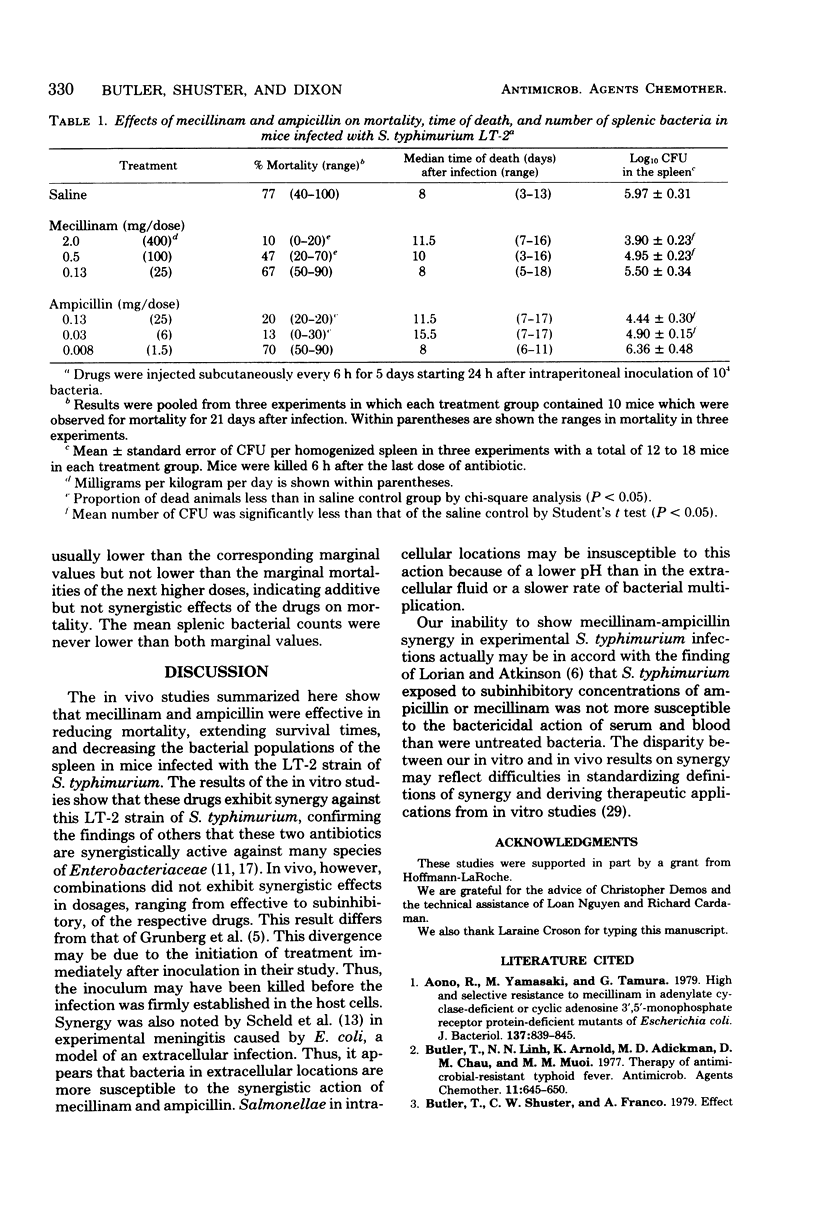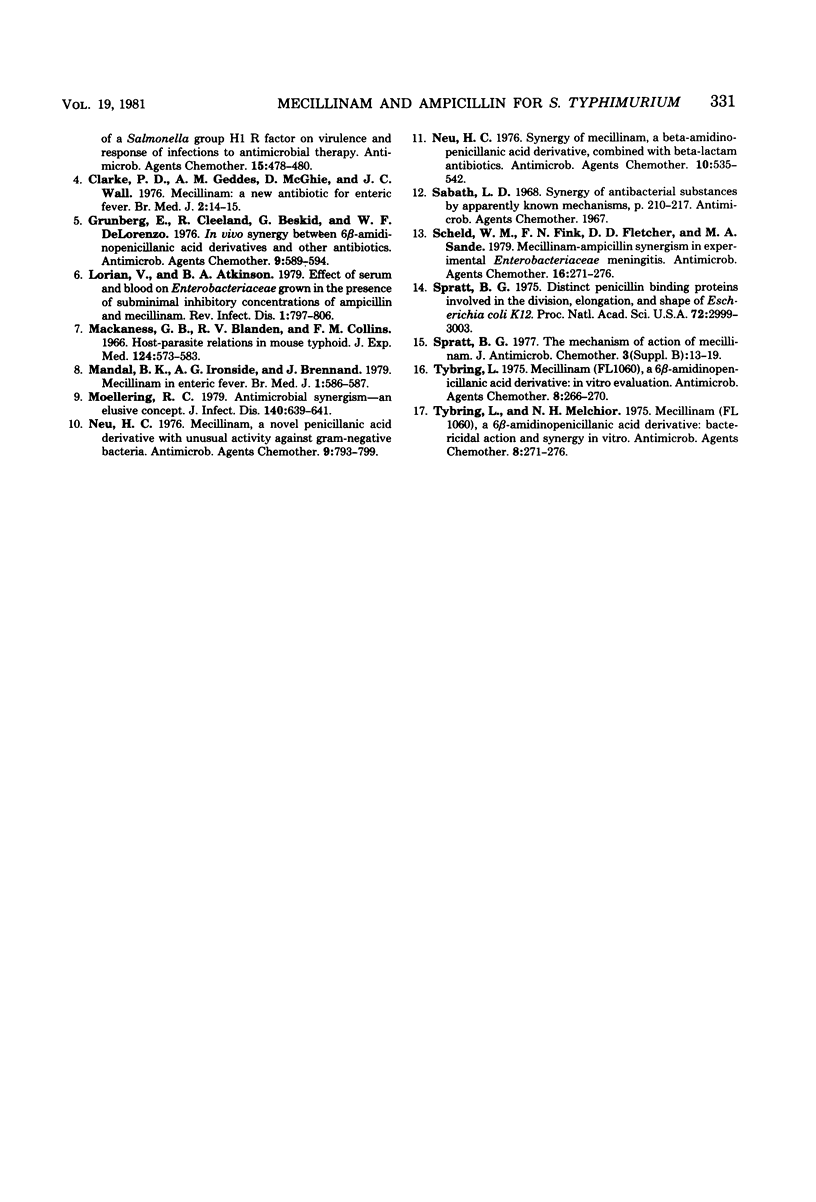Abstract
The activities of mecillinam and ampicillin, alone and in combination, were evaluated in mice infected with the LT-2 strain of Salmonella typhimurium. The minimal inhibitory concentrations of mecillinam and ampicillin for this strain were, respectively, 6.2 and 0.4 microgram/ml of culture medium. In vitro synergy was demonstrated. CF-1 mice inoculated intraperitoneally with 10(4) colony-forming units of the LT-2 strain were used in the therapeutic assessments. Treatment of subgroups with graded doses of the respective penicillins or their combination was initiated 24 h after inoculation and repeated at 6-h intervals for 5 consecutive days. Animals were observed during 21 days for mortality or sacrificed for quantitative cultures of spleen homogenates at the end of the treatment. Ampicillin in doses of greater than or equal to 0.03 mg and mecillinam in doses of greater than or equal to mg reduced mortality rates from 77% in the saline-treated controls to a range of 0 to 4% (P less than 0.05). The same doses of antibiotics also extended the median times to death and lowered significantly the means of splenic bacterial counts. When both drugs were combined in doses that were partially effective or subinhibitory alone, no synergistic effects were observed. These results showed that mecillinam and ampicillin given alone were effective in treating S. typhimurium infection but that combinations of the two drugs were not synergistic in controlling the course of infections.
Full text
PDF



Selected References
These references are in PubMed. This may not be the complete list of references from this article.
- Aono R., Yamasaki M., Tamura G. High and selective resistance to mecillinam in adenylate cyclase-deficient or cyclic adenosine 3',5'-monophosphate receptor protein-deficient mutants of Escherichia coli. J Bacteriol. 1979 Feb;137(2):839–845. doi: 10.1128/jb.137.2.839-845.1979. [DOI] [PMC free article] [PubMed] [Google Scholar]
- Butler T., Linh N. N., Arnold K., Adickman M. D., Chau D. M., Muoi M. M. Therapy of antimicrobial-resistant typhoid fever. Antimicrob Agents Chemother. 1977 Apr;11(4):645–650. doi: 10.1128/aac.11.4.645. [DOI] [PMC free article] [PubMed] [Google Scholar]
- Butler T., Shuster C. W., Franco A. Effect of a Salmonella group H1 R factor on virulence and response of infections to antimicrobial therapy. Antimicrob Agents Chemother. 1979 Mar;15(3):478–480. doi: 10.1128/aac.15.3.478. [DOI] [PMC free article] [PubMed] [Google Scholar]
- Clarke P. D., Geddes A. M., McGhie D., Wall J. C. Mecillinam: a new antibiotic for enteric fever. Br Med J. 1976 Jul 3;2(6026):14–15. doi: 10.1136/bmj.2.6026.14. [DOI] [PMC free article] [PubMed] [Google Scholar]
- Grunberg E., Cleeland R., Beskid G., DeLorenzo W. F. In vivo synergy between 6 beta-amidinopenicillanic acid derivatives and other antibiotics. Antimicrob Agents Chemother. 1976 Apr;9(4):589–594. doi: 10.1128/aac.9.4.589. [DOI] [PMC free article] [PubMed] [Google Scholar]
- Lorian V., Atkinson B. A. Effect of serum and blood on Enterobacteriaceae grown in the presence of subminimal inhibitory concentrations of ampicillin and mecillinam. Rev Infect Dis. 1979 Sep-Oct;1(5):797–806. doi: 10.1093/clinids/1.5.797. [DOI] [PubMed] [Google Scholar]
- Mackaness G. B., Blanden R. V., Collins F. M. Host-parasite relations in mouse typhoid. J Exp Med. 1966 Oct 1;124(4):573–583. doi: 10.1084/jem.124.4.573. [DOI] [PMC free article] [PubMed] [Google Scholar]
- Mandal B. K., Ironside A. G., Brennand J. Mecillinam in enteric fever. Br Med J. 1979 Mar 3;1(6163):586–587. doi: 10.1136/bmj.1.6163.586. [DOI] [PMC free article] [PubMed] [Google Scholar]
- Moellering R. C., Jr Antimicrobial synergism--an elusive concept. J Infect Dis. 1979 Oct;140(4):639–641. doi: 10.1093/infdis/140.4.639. [DOI] [PubMed] [Google Scholar]
- Neu H. C. Mecillinam, a novel penicillanic acid derivative with unusual activity against gram-negative bacteria. Antimicrob Agents Chemother. 1976 May;9(5):793–799. doi: 10.1128/aac.9.5.793. [DOI] [PMC free article] [PubMed] [Google Scholar]
- Neu J. C. Synergy of mecillinam, a beta-amidinopenicillanic acid derivative, combined with beta-lactam antibiotics. Antimicrob Agents Chemother. 1976 Sep;10(3):535–542. doi: 10.1128/aac.10.3.535. [DOI] [PMC free article] [PubMed] [Google Scholar]
- Scheld W. M., Fink F. N., Fletcher D. D., Sande M. A. Mecillinam-ampicillin synergism in experimental Enterobacteriaceae meningitis. Antimicrob Agents Chemother. 1979 Sep;16(3):271–276. doi: 10.1128/aac.16.3.271. [DOI] [PMC free article] [PubMed] [Google Scholar]
- Spratt B. G. Distinct penicillin binding proteins involved in the division, elongation, and shape of Escherichia coli K12. Proc Natl Acad Sci U S A. 1975 Aug;72(8):2999–3003. doi: 10.1073/pnas.72.8.2999. [DOI] [PMC free article] [PubMed] [Google Scholar]
- Spratt B. G. The mechanism of action of mecillinam. J Antimicrob Chemother. 1977 Jul;3 (Suppl B):13–19. doi: 10.1093/jac/3.suppl_b.13. [DOI] [PubMed] [Google Scholar]
- Tybring L. Mecillinam (FL 1060), a 6beta-amidinopenicillanic acid derivative: in vitro evaluation. Antimicrob Agents Chemother. 1975 Sep;8(3):266–270. doi: 10.1128/aac.8.3.266. [DOI] [PMC free article] [PubMed] [Google Scholar]
- Tybring L., Melchior N. H. Mecillinam (FL 1060), a 6beta-amidinopenicillanic acid derivative: bactericidal action and synergy in vitro. Antimicrob Agents Chemother. 1975 Sep;8(3):271–276. doi: 10.1128/aac.8.3.271. [DOI] [PMC free article] [PubMed] [Google Scholar]


